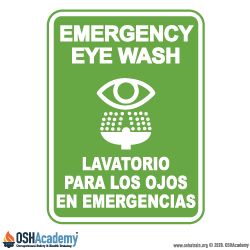Hierarchy of Controls
Administrative/Work Practice Controls
Poor work practices can contribute significantly to an employee's glutaraldehyde exposure.
The health care facility should evaluate each glutaraldehyde-using operation, develop safe work procedures and practices, conduct adequate training, and observe employees' work practices on the job to determine all potential sources of exposure.
Procedures and practices should emphasize prevention of employee contact with glutaraldehyde solution or vapors. Only competent persons who are properly trained and certified employees should be allowed to handle glutaraldehyde.
Here are some more hazard control measures using substitution, administrative/work practice controls, and PPE to help protect healthcare workers:
- Use less toxic products if feasible and available for sterilization.
- Automate the transfer of pure glutaraldehyde or pump liquid glutaraldehyde from drums or other storage containers.
- Use local exhaust ventilation or work in well-ventilated areas to reduce airborne concentrations.
- Use a vacuum or wet method to reduce dust while cleaning up pure glutaraldehyde. Do not dry sweep.
- Avoid direct skin contact and inhalation by using fume hoods or closed systems when possible.
- Keep glutaraldehyde in tightly sealed containers, away from heat and direct sunlight.
- Clean spills immediately using absorbent materials and dispose of them properly.
- Do not eat, drink, or smoke in any area where glutaraldehyde is handled or stored.
- Have eyewash stations and emergency showers nearby, and train employees on first aid procedures. Flush area with water for at least 15 minutes to remove chemical.
- Change into clean clothes if clothing becomes contaminated.
- Wear chemical-resistant gloves (e.g., nitrile or butyl rubber), safety goggles or face shields, and lab coats or aprons.
Case Report
Several nurses were working in an area where glutaraldehyde was stored in 1-liter baths on countertops and was used to disinfect bronchoscopes. They complained of hives, chest tightness, and watery eyes. Evaluation of the work area indicated that there was a separate (independent) recirculating ventilation system designed to provide 10% outside air. The nurses used no personal protective equipment (such as gloves). Measures were then taken to reduce exposures. These included changing glutaraldehyde containers to air-tight models, using appropriate gloves, and installing local ventilation hoods for glutaraldehyde stations. One month after the implementation of these measures, the nurses' symptoms subsided [Charney 1991].
Knowledge Check Choose the best answer for the question.
1-6. Who should be allowed to handle glutaraldehyde in the healthcare setting?
You forgot to answer the question!

